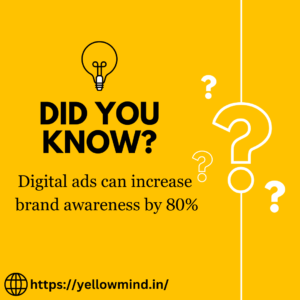Facebook and Instagram are among the social media networks owned by Meta Platforms, formerly known as Facebook Inc. The tool for making adverts that appear on various platforms is called Meta Ads. With the use of these advertisements, businesses may reach a highly relevant audience by focusing on particular demographics and hobbies. Finding the correct audience for your message may be like trying to find a needle in a haystack in the modern digital world. But do not worry, your newfound secret weapon is going to be Meta Ads (previously Facebook Ads).

how ads benefit businesses?
Enhanced Recognition of Brand-
Targeted Reach: Don’t stop at just displaying your brand to people. You may target particular demographics (age, geography, income) and psychographics (interests, hobbies, behaviours) via ad platforms like Meta Ads (previously Facebook Ads). By doing this, you can be sure that those who are most likely to be open to your brand will hear your message.
Repetition and Frequency: Well-placed advertisements can introduce prospective buyers to your business several times. Repetition creates familiarity and trust, increasing the likelihood that someone would think of your brand when they have a need that you can meet.
Brand Storytelling: Product placement isn’t the only thing advertisements can do. Companies may utilise them to create captivating narratives that highlight their goal, values, and overall effect. This kind of emotional bonding might promote brand loyalty.
Expanding Your Audience:
Beyond Geographical limits: Geographic limits frequently impose restrictions on traditional advertising. By enabling you to target consumers in several states, cities, or even nations, digital advertisements help your company expand internationally.
Finding Niche Audiences: Digital advertisements can assist you in identifying your niche market if your product or service is highly specialised. You may establish a connection with a highly relevant and engaged audience by focusing on their individual interests and online behaviour.
Using Social Proof: Ads may use endorsements, favourable reviews, or mentions on social media. Social proof helps potential buyers who might be wary of a new company feel more credible and trustworthy.
Increasing Leads and Sales with Explicit Calls to Action Advertisements that are effective clearly state what you want viewers to do next. This may be clicking on to your website, registering for a free trial, or buying anything straight from the advertisement.
Retargeting Campaigns: You may retarget website visitors who haven’t converted yet using a number of ad networks. This motivates consumers to finish the desired activity by keeping your brand front and centre in their minds.
Offering Incentives: Special discounts, deals, and free consultations can all be advertised through advertisements. By offering these incentives, you may persuade prospective clients to trial your good or service before they become paying clients.
Creating a Brand Image:
Emotional Connection: Advertisements might be designed to make viewers feel a certain way. They might inspire aspirations, be humorous, endearing, or foster a feeling of community. An association that is favourable for your brand is produced by these emotional connections.
Visual Storytelling: Using sharp photos and videos may draw viewers in and clearly convey your brand’s message. Potential clients will find your product or service more tempting if they can see the lifestyle that goes along with it.
Consistent Messaging: A feeling of coherence and professionalism is created when your advertisements all use the same visual identity and brand language. This helps people recognise you and strengthens the perception of your brand.

HOW IS AD MANAGER USED IN RUNNING META ADS?
The platform Ads Manager is specifically designed for creating and managing campaigns for Meta Ads, which were formerly known as Facebook Ads. In general, Ad Manager wouldn’t communicate directly with Meta Ads.
This is an outline of each of their distinct duties.
Manager of Meta Ads: This is where your Meta Ads campaigns are controlled. This is where you identify your target market, create ad creatives, allocate funds, create timetables, and monitor campaign results. It’s where your Meta Ads’ content and strategy come to life.
Ad Manager: This is a stand-alone platform for managing the advertising space on your website or mobile application. Although it doesn’t expressly produce Meta Ads, it could show them. Ad Manager would handle auctions and ad placement for any ad source, including Meta Ads, if your website opted to show them through that platform.
HOW TO USE AD MANAGER?
The following describes how to use Ad Manager to control the ad space on your website or mobile application:
Arranging Your Inventory:
Determine Ad Units: Find strategic locations on your website or app where advertisements may be shown off to best advantage. These might be video slots, text ad boxes, or banner placements.
Set Ad Unit Dimensions: Provide the width and height of each ad unit to make sure the ads flow naturally into the allotted area.
Make Ad Tags: For every unit, Ad Manager creates a special ad tag. The location of the advertisement is subsequently indicated by this code snippet, which is then added to the code of your website or app.
Ad Rules Management:
Limit how frequently a certain advertisement may be presented to the same user by implementing frequency capping. This enhances the overall ad experience by preventing consumers from viewing the same advertisement repeatedly.
Targeting Rules: Specify which advertisements are eligible to run in certain ad units. For instance, you may exclude specific kinds of content from your website or give priority to advertisements that are pertinent to the surrounding content.
Delivery and Enhancement:
Real-Time Auctions: The ad tag for a particular unit in Ad Manager starts an auction when a user visits your website or mobile application. Bids and targeting are two criteria that determine how eligible advertising compete.
Ad Serving: The chosen ad unit is where the winning advertisement is shown. Ad Manager monitors clicks, impressions, and other data to provide you important information about how well your ads are doing.
Reporting and Optimisation: To learn which ad units work best, which ad sources are most lucrative, and how user behaviour interacts with the advertising, utilise the reports that Ad Manager generates. You may improve your advertising approach over time by using this data.
HOW ARE META ADS USEFUL FOR SMALL BUSINESSES?
For companies of all sizes, Meta Ads (previously Facebook Ads) provide an effective advertising toolbox. Here’s where they can be very helpful:
Targeted Reach: Let’s say a bakery wants to market its freshly made cupcakes to the sweet tooths in the neighbourhood. With meta ads, demographics (such as age and area) and interests (such as previous recipe browsing activity) may be precisely targeted. Unlike traditional advertising, which has a wider reach and maybe results in wasted impressions, this guarantees the advertisement reaches those who are most likely to want those cupcakes.
Brand Awareness and Storytelling: Using eye-catching films or pictures, a nearby yoga studio may utilise Meta Ads to highlight its serene environment and wide range of class options. This attracts new students who are interested in a mindful practice and increases brand exposure beyond their physical location.
Lead generation and sales promotion: Targeted Meta Ads showcasing the newest summer collection can be made by an online clothes retailer. They can encourage potential customers to their website to make purchases by including discount coupons or special deals in the advertisement itself. This draws attention while it’s hot and shortens the sales funnel.
Measurable Outcomes and Budget Flexibility: Comprehensive data on impressions, clicks, and conversions are offered via meta ads. This makes it possible for companies, particularly small ones with little resources, to monitor their return on investment (ROI) and tailor their marketing initiatives for optimal effect. Depending on whether targeting strategies or ad versions work best, they can modify the amount of money they allocate.
To put it simply, Meta Ads enable companies to communicate their brand narrative, attract the relevant audience, create leads, and increase sales in a method that is both quantifiable and economical. They are therefore an invaluable resource for companies of all kinds, from local bakers to internet apparel retailers.
Meta Ads vs. Google Ads: A Deep Dive into the Differences
In the realm of online advertising, Meta Ads (previously Facebook Ads) and Google Ads are titans, each with special advantages and targeting options. The ideal platform to choose will rely on your target market and unique marketing objectives. Below is a thorough explanation of their main distinctions:
User Intent and Platform:
Meta Ads: Runs on WhatsApp, Instagram, Facebook, and other social media networks. Most users are either consuming engaging material, checking up with friends and family, or scrolling through their accounts. With Meta Ads, you can target users according to their psychographics (interests, hobbies, and behaviours) as well as demographics (age and location).
By targeting individuals based on their lifestyle or prior behaviour, you may increase brand recognition and encourage them to consider your product or service.
Google AdWords: Predominately targets search terms. It makes use of partnered websites, YouTube, Google Search, and other Google assets. Users are actively looking for items or information here. Google Ads is great at focusing on people who are looking to buy or are investigating alternatives that are similar to what you are selling. Consider it as a way to connect with people at a time when they are actively seeking solutions and have a specific need.
Strategies for Targeting:
Meta Ads: Provides a comprehensive user data mosaic on Instagram and Facebook. Campaigns that are highly targeted may be made using data on behaviours, interests, demographics, and even past purchases. By taking into account things like their lifestyle preferences, previous online activity, or even life events, you may target individuals with extreme precision (e.g., targeting new parents with baby goods adverts).
Google Ads: Targets consumers mostly according to their search terms, browsing habits, and keywords. Users can be targeted according to the exact keywords they use in their searches (such as “best running shoes”) or the websites they visit (such as those selling sports gear). Because of this, it’s perfect for attracting customers who are actively seeking for the services or goods you provide and have a high buy intent.
Campaign Goals and Advantages:
Meta Ads: Ideal for campaigns centred around:
Brand awareness is the process of making your brand known and creating a perception of your brand among prospective consumers.
Brand Preference: Getting people to see your brand more favourably than that of your rivals.
Lead generation is the process of gathering prospective individuals’ contact information for upcoming marketing activities, such as email campaigns.
Increasing website traffic allows users to explore your services and discover more about your brand on your website or app.
Although Meta Ads are useful for sales and conversions, they might not be as successful as Google Ads for direct product searches when people are very likely to make a purchase.
Google Ads: Outstanding in driving:
Targeted Traffic: Driving more likely-to-convert users to your website or app by directing qualified visitors there.
Getting visitors to perform desired activities on your website, including buying products, signing up for services, or installing apps, is known as website conversions.
Promoting Particular Goods or Services: Increase conversion rates by connecting with those who are actively looking for what you have to offer.
Price and Expense:
Meta Ads: Depending on the competition and available targeting choices, the cost-per-click (CPC) might change. It is typically less expensive than Google Ads, particularly for larger awareness initiatives. However, for highly targeted ads with certain interests or demographics, the price might increase dramatically.
Google Ads: CPC may be more expensive, especially for popular phrases that receive a lot of search traffic. This is a result of your users’ increased buying intent. The conversion rate—the proportion of clicks that result in a sale—can be greater since customers are actively looking for what you have to offer, which might improve your return on investment (ROI).
Selecting the Appropriate Platform:
The ideal platform is determined by your unique marketing objectives. Here’s a short rule of thumb:
Meta Ads are a great option for interaction on social media and for generating.
Google Ads may be more successful at marketing particular goods and services, generating targeted traffic, and converting users.
Nonetheless, companies may use the advantages of both platforms to create a thorough digital advertising plan.
Creating brand recognition, piquing user interest, and producing leads are three top-of-the-funnel marketing objectives that may be achieved using meta advertisements.
Bottom-of-the-funnel marketing may be achieved by using Google Ads to maximise sales, drive conversions, and capture consumers at the moment of buying intent.
You may reach your target audience more successfully and accomplish your marketing goals by being aware of the unique advantages and targeting options of Google Ads and Meta Ads.



